Project Global Management
VerifiedAdded on 2023/06/04
|11
|2377
|396
AI Summary
This report analyzes the business process of Taco Bill, a restaurant in Australia, using process mapping. It identifies issues and proposes a to-be model with decision-making steps to enhance the existing model. The report discusses the limitations and benefits of business process mapping. The subject is Business Process Management, and the course code is not mentioned. The course name and university are also not mentioned.
Contribute Materials
Your contribution can guide someone’s learning journey. Share your
documents today.
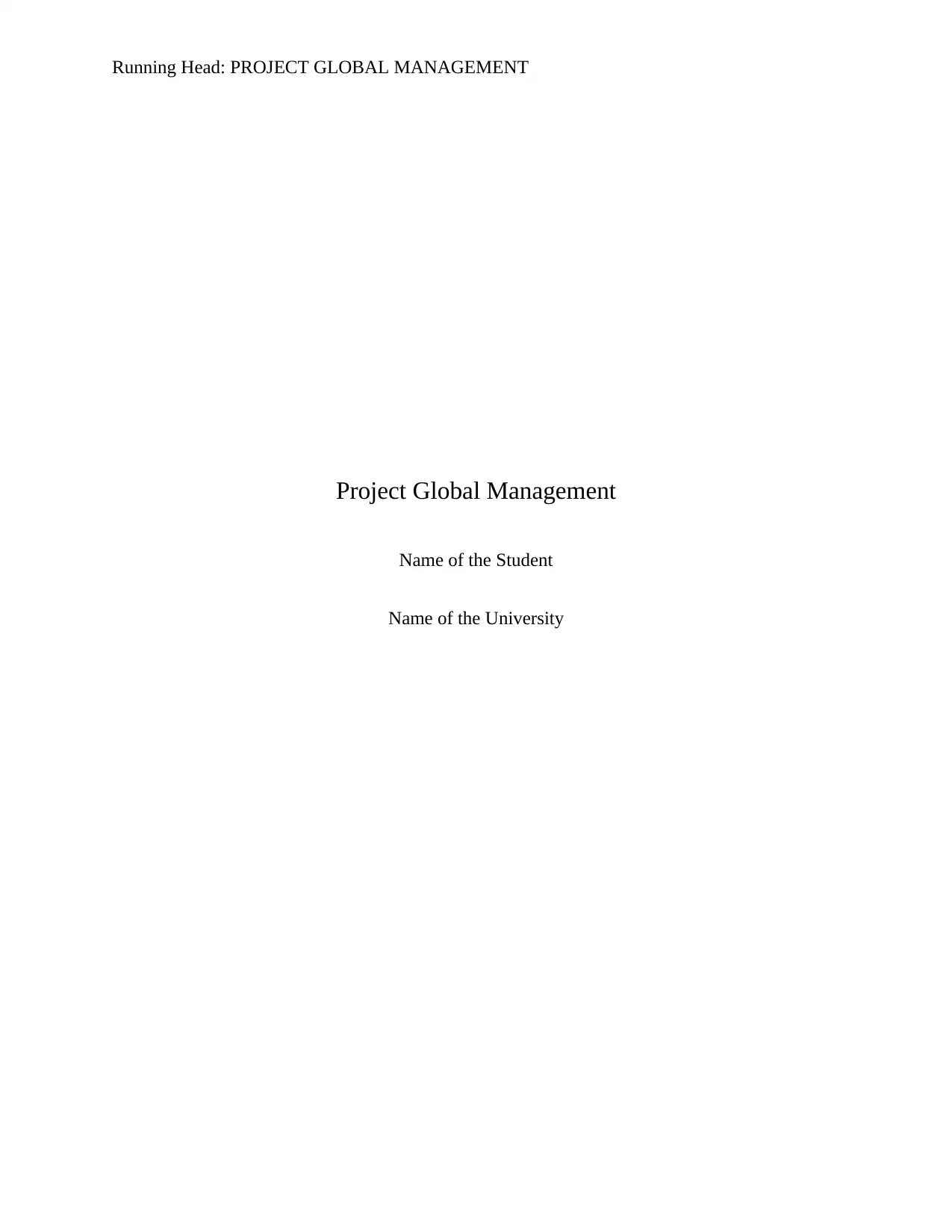
Running Head: PROJECT GLOBAL MANAGEMENT
Project Global Management
Name of the Student
Name of the University
Project Global Management
Name of the Student
Name of the University
Secure Best Marks with AI Grader
Need help grading? Try our AI Grader for instant feedback on your assignments.

1PROJECT GLOBAL MANAGEMENT
Table of Contents
Introduction......................................................................................................................................2
Business Process Briefing................................................................................................................2
Process Mapping..............................................................................................................................3
Critical Analysis of the Process Mapping.......................................................................................5
Conclusion.......................................................................................................................................7
References........................................................................................................................................9
Table of Contents
Introduction......................................................................................................................................2
Business Process Briefing................................................................................................................2
Process Mapping..............................................................................................................................3
Critical Analysis of the Process Mapping.......................................................................................5
Conclusion.......................................................................................................................................7
References........................................................................................................................................9
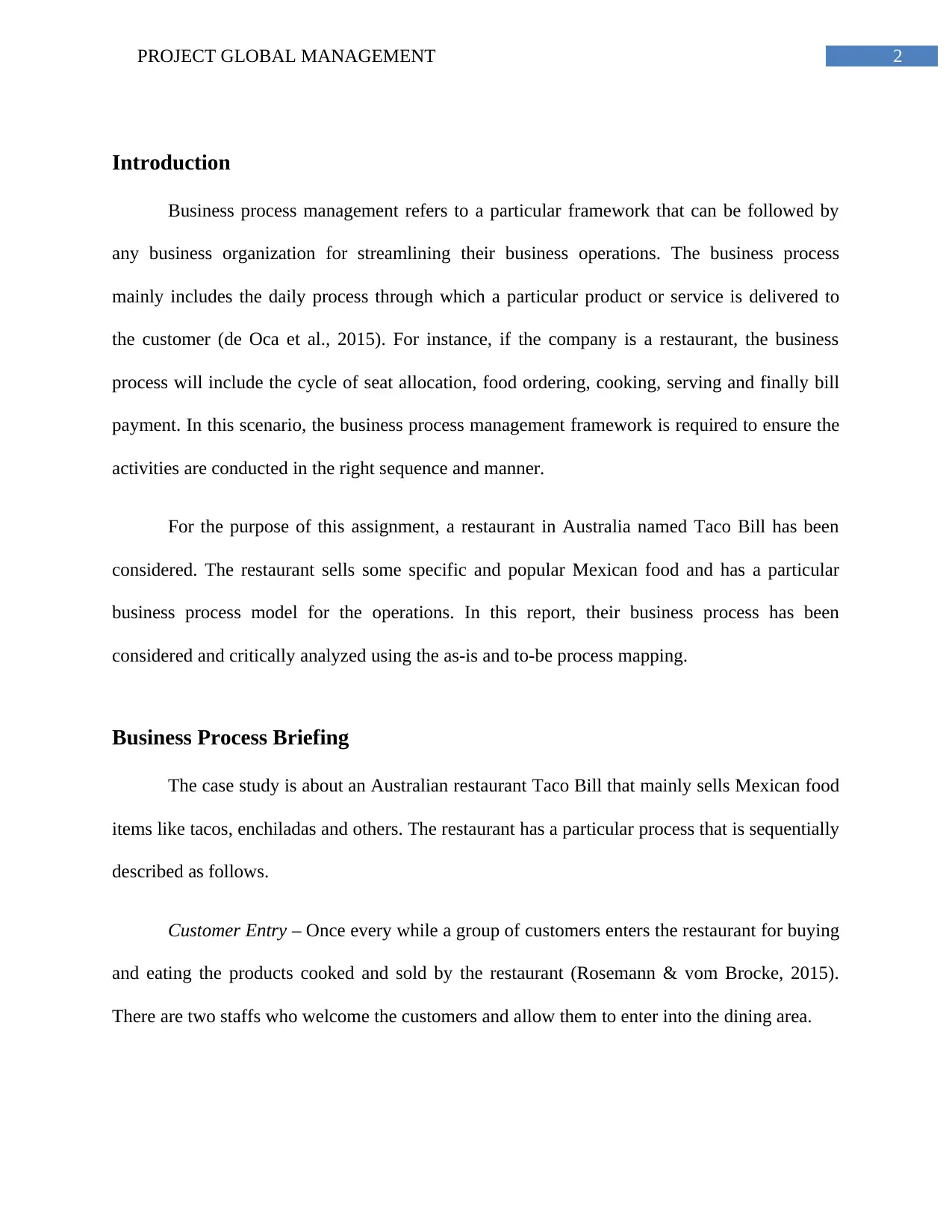
2PROJECT GLOBAL MANAGEMENT
Introduction
Business process management refers to a particular framework that can be followed by
any business organization for streamlining their business operations. The business process
mainly includes the daily process through which a particular product or service is delivered to
the customer (de Oca et al., 2015). For instance, if the company is a restaurant, the business
process will include the cycle of seat allocation, food ordering, cooking, serving and finally bill
payment. In this scenario, the business process management framework is required to ensure the
activities are conducted in the right sequence and manner.
For the purpose of this assignment, a restaurant in Australia named Taco Bill has been
considered. The restaurant sells some specific and popular Mexican food and has a particular
business process model for the operations. In this report, their business process has been
considered and critically analyzed using the as-is and to-be process mapping.
Business Process Briefing
The case study is about an Australian restaurant Taco Bill that mainly sells Mexican food
items like tacos, enchiladas and others. The restaurant has a particular process that is sequentially
described as follows.
Customer Entry – Once every while a group of customers enters the restaurant for buying
and eating the products cooked and sold by the restaurant (Rosemann & vom Brocke, 2015).
There are two staffs who welcome the customers and allow them to enter into the dining area.
Introduction
Business process management refers to a particular framework that can be followed by
any business organization for streamlining their business operations. The business process
mainly includes the daily process through which a particular product or service is delivered to
the customer (de Oca et al., 2015). For instance, if the company is a restaurant, the business
process will include the cycle of seat allocation, food ordering, cooking, serving and finally bill
payment. In this scenario, the business process management framework is required to ensure the
activities are conducted in the right sequence and manner.
For the purpose of this assignment, a restaurant in Australia named Taco Bill has been
considered. The restaurant sells some specific and popular Mexican food and has a particular
business process model for the operations. In this report, their business process has been
considered and critically analyzed using the as-is and to-be process mapping.
Business Process Briefing
The case study is about an Australian restaurant Taco Bill that mainly sells Mexican food
items like tacos, enchiladas and others. The restaurant has a particular process that is sequentially
described as follows.
Customer Entry – Once every while a group of customers enters the restaurant for buying
and eating the products cooked and sold by the restaurant (Rosemann & vom Brocke, 2015).
There are two staffs who welcome the customers and allow them to enter into the dining area.
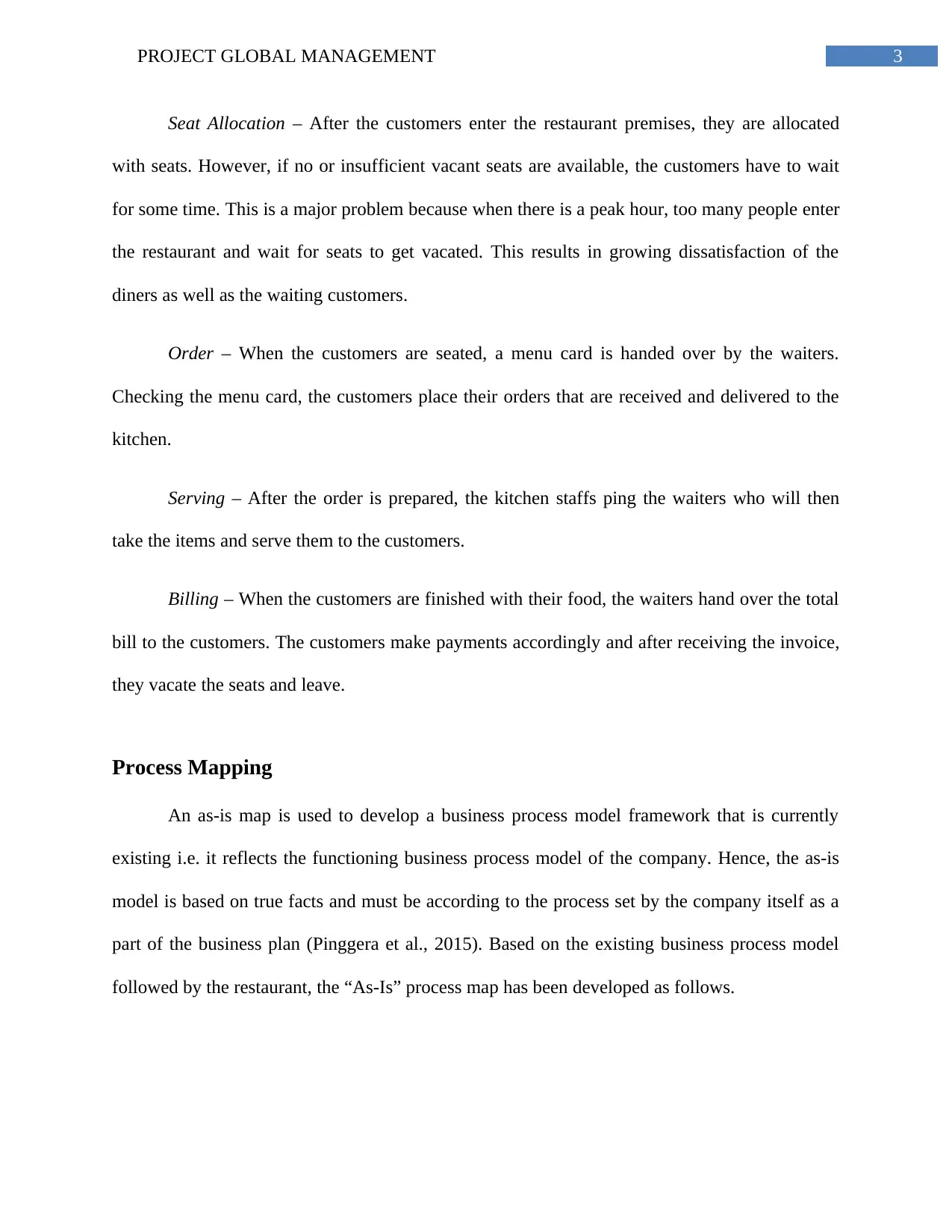
3PROJECT GLOBAL MANAGEMENT
Seat Allocation – After the customers enter the restaurant premises, they are allocated
with seats. However, if no or insufficient vacant seats are available, the customers have to wait
for some time. This is a major problem because when there is a peak hour, too many people enter
the restaurant and wait for seats to get vacated. This results in growing dissatisfaction of the
diners as well as the waiting customers.
Order – When the customers are seated, a menu card is handed over by the waiters.
Checking the menu card, the customers place their orders that are received and delivered to the
kitchen.
Serving – After the order is prepared, the kitchen staffs ping the waiters who will then
take the items and serve them to the customers.
Billing – When the customers are finished with their food, the waiters hand over the total
bill to the customers. The customers make payments accordingly and after receiving the invoice,
they vacate the seats and leave.
Process Mapping
An as-is map is used to develop a business process model framework that is currently
existing i.e. it reflects the functioning business process model of the company. Hence, the as-is
model is based on true facts and must be according to the process set by the company itself as a
part of the business plan (Pinggera et al., 2015). Based on the existing business process model
followed by the restaurant, the “As-Is” process map has been developed as follows.
Seat Allocation – After the customers enter the restaurant premises, they are allocated
with seats. However, if no or insufficient vacant seats are available, the customers have to wait
for some time. This is a major problem because when there is a peak hour, too many people enter
the restaurant and wait for seats to get vacated. This results in growing dissatisfaction of the
diners as well as the waiting customers.
Order – When the customers are seated, a menu card is handed over by the waiters.
Checking the menu card, the customers place their orders that are received and delivered to the
kitchen.
Serving – After the order is prepared, the kitchen staffs ping the waiters who will then
take the items and serve them to the customers.
Billing – When the customers are finished with their food, the waiters hand over the total
bill to the customers. The customers make payments accordingly and after receiving the invoice,
they vacate the seats and leave.
Process Mapping
An as-is map is used to develop a business process model framework that is currently
existing i.e. it reflects the functioning business process model of the company. Hence, the as-is
model is based on true facts and must be according to the process set by the company itself as a
part of the business plan (Pinggera et al., 2015). Based on the existing business process model
followed by the restaurant, the “As-Is” process map has been developed as follows.
Secure Best Marks with AI Grader
Need help grading? Try our AI Grader for instant feedback on your assignments.
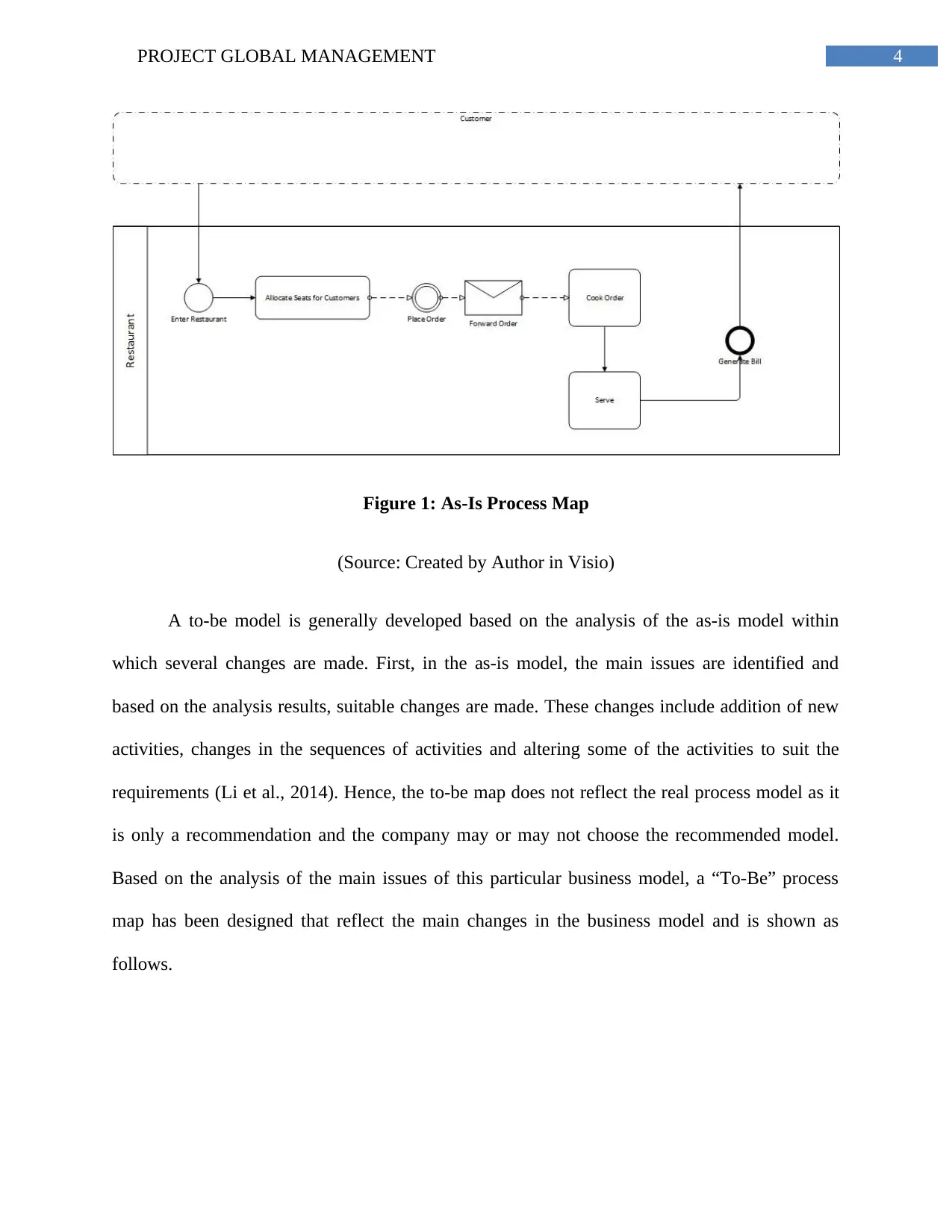
4PROJECT GLOBAL MANAGEMENT
Figure 1: As-Is Process Map
(Source: Created by Author in Visio)
A to-be model is generally developed based on the analysis of the as-is model within
which several changes are made. First, in the as-is model, the main issues are identified and
based on the analysis results, suitable changes are made. These changes include addition of new
activities, changes in the sequences of activities and altering some of the activities to suit the
requirements (Li et al., 2014). Hence, the to-be map does not reflect the real process model as it
is only a recommendation and the company may or may not choose the recommended model.
Based on the analysis of the main issues of this particular business model, a “To-Be” process
map has been designed that reflect the main changes in the business model and is shown as
follows.
Figure 1: As-Is Process Map
(Source: Created by Author in Visio)
A to-be model is generally developed based on the analysis of the as-is model within
which several changes are made. First, in the as-is model, the main issues are identified and
based on the analysis results, suitable changes are made. These changes include addition of new
activities, changes in the sequences of activities and altering some of the activities to suit the
requirements (Li et al., 2014). Hence, the to-be map does not reflect the real process model as it
is only a recommendation and the company may or may not choose the recommended model.
Based on the analysis of the main issues of this particular business model, a “To-Be” process
map has been designed that reflect the main changes in the business model and is shown as
follows.
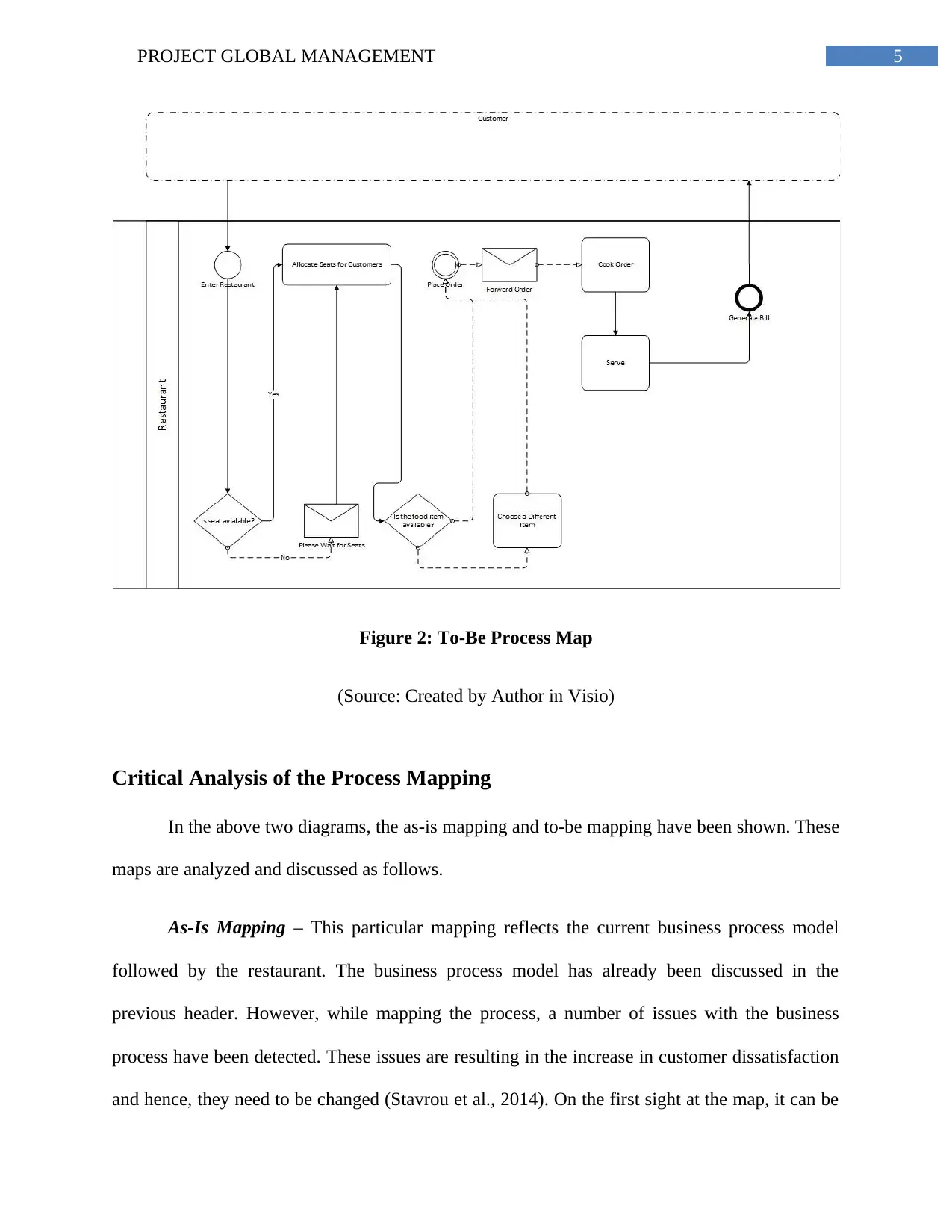
5PROJECT GLOBAL MANAGEMENT
Figure 2: To-Be Process Map
(Source: Created by Author in Visio)
Critical Analysis of the Process Mapping
In the above two diagrams, the as-is mapping and to-be mapping have been shown. These
maps are analyzed and discussed as follows.
As-Is Mapping – This particular mapping reflects the current business process model
followed by the restaurant. The business process model has already been discussed in the
previous header. However, while mapping the process, a number of issues with the business
process have been detected. These issues are resulting in the increase in customer dissatisfaction
and hence, they need to be changed (Stavrou et al., 2014). On the first sight at the map, it can be
Figure 2: To-Be Process Map
(Source: Created by Author in Visio)
Critical Analysis of the Process Mapping
In the above two diagrams, the as-is mapping and to-be mapping have been shown. These
maps are analyzed and discussed as follows.
As-Is Mapping – This particular mapping reflects the current business process model
followed by the restaurant. The business process model has already been discussed in the
previous header. However, while mapping the process, a number of issues with the business
process have been detected. These issues are resulting in the increase in customer dissatisfaction
and hence, they need to be changed (Stavrou et al., 2014). On the first sight at the map, it can be
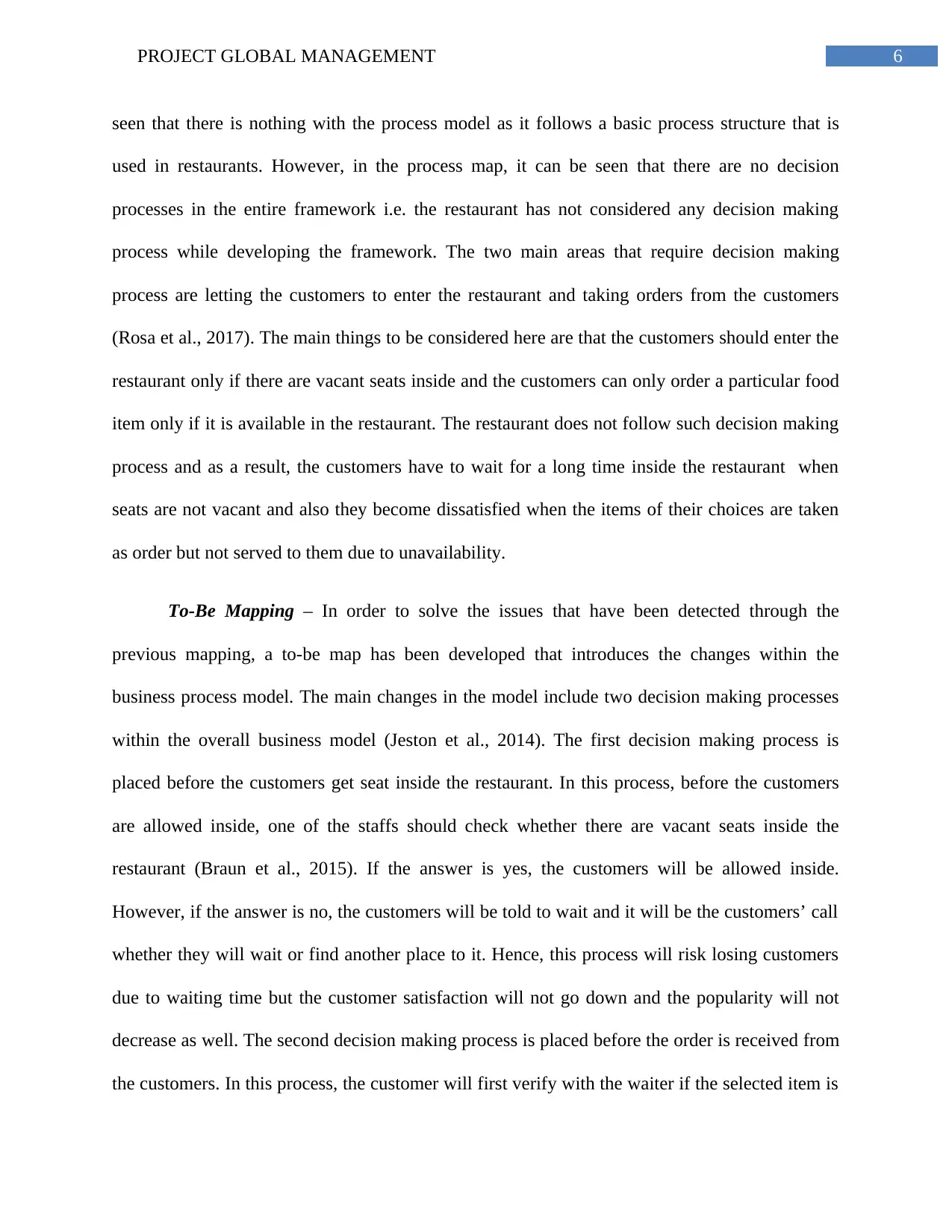
6PROJECT GLOBAL MANAGEMENT
seen that there is nothing with the process model as it follows a basic process structure that is
used in restaurants. However, in the process map, it can be seen that there are no decision
processes in the entire framework i.e. the restaurant has not considered any decision making
process while developing the framework. The two main areas that require decision making
process are letting the customers to enter the restaurant and taking orders from the customers
(Rosa et al., 2017). The main things to be considered here are that the customers should enter the
restaurant only if there are vacant seats inside and the customers can only order a particular food
item only if it is available in the restaurant. The restaurant does not follow such decision making
process and as a result, the customers have to wait for a long time inside the restaurant when
seats are not vacant and also they become dissatisfied when the items of their choices are taken
as order but not served to them due to unavailability.
To-Be Mapping – In order to solve the issues that have been detected through the
previous mapping, a to-be map has been developed that introduces the changes within the
business process model. The main changes in the model include two decision making processes
within the overall business model (Jeston et al., 2014). The first decision making process is
placed before the customers get seat inside the restaurant. In this process, before the customers
are allowed inside, one of the staffs should check whether there are vacant seats inside the
restaurant (Braun et al., 2015). If the answer is yes, the customers will be allowed inside.
However, if the answer is no, the customers will be told to wait and it will be the customers’ call
whether they will wait or find another place to it. Hence, this process will risk losing customers
due to waiting time but the customer satisfaction will not go down and the popularity will not
decrease as well. The second decision making process is placed before the order is received from
the customers. In this process, the customer will first verify with the waiter if the selected item is
seen that there is nothing with the process model as it follows a basic process structure that is
used in restaurants. However, in the process map, it can be seen that there are no decision
processes in the entire framework i.e. the restaurant has not considered any decision making
process while developing the framework. The two main areas that require decision making
process are letting the customers to enter the restaurant and taking orders from the customers
(Rosa et al., 2017). The main things to be considered here are that the customers should enter the
restaurant only if there are vacant seats inside and the customers can only order a particular food
item only if it is available in the restaurant. The restaurant does not follow such decision making
process and as a result, the customers have to wait for a long time inside the restaurant when
seats are not vacant and also they become dissatisfied when the items of their choices are taken
as order but not served to them due to unavailability.
To-Be Mapping – In order to solve the issues that have been detected through the
previous mapping, a to-be map has been developed that introduces the changes within the
business process model. The main changes in the model include two decision making processes
within the overall business model (Jeston et al., 2014). The first decision making process is
placed before the customers get seat inside the restaurant. In this process, before the customers
are allowed inside, one of the staffs should check whether there are vacant seats inside the
restaurant (Braun et al., 2015). If the answer is yes, the customers will be allowed inside.
However, if the answer is no, the customers will be told to wait and it will be the customers’ call
whether they will wait or find another place to it. Hence, this process will risk losing customers
due to waiting time but the customer satisfaction will not go down and the popularity will not
decrease as well. The second decision making process is placed before the order is received from
the customers. In this process, the customer will first verify with the waiter if the selected item is
Paraphrase This Document
Need a fresh take? Get an instant paraphrase of this document with our AI Paraphraser
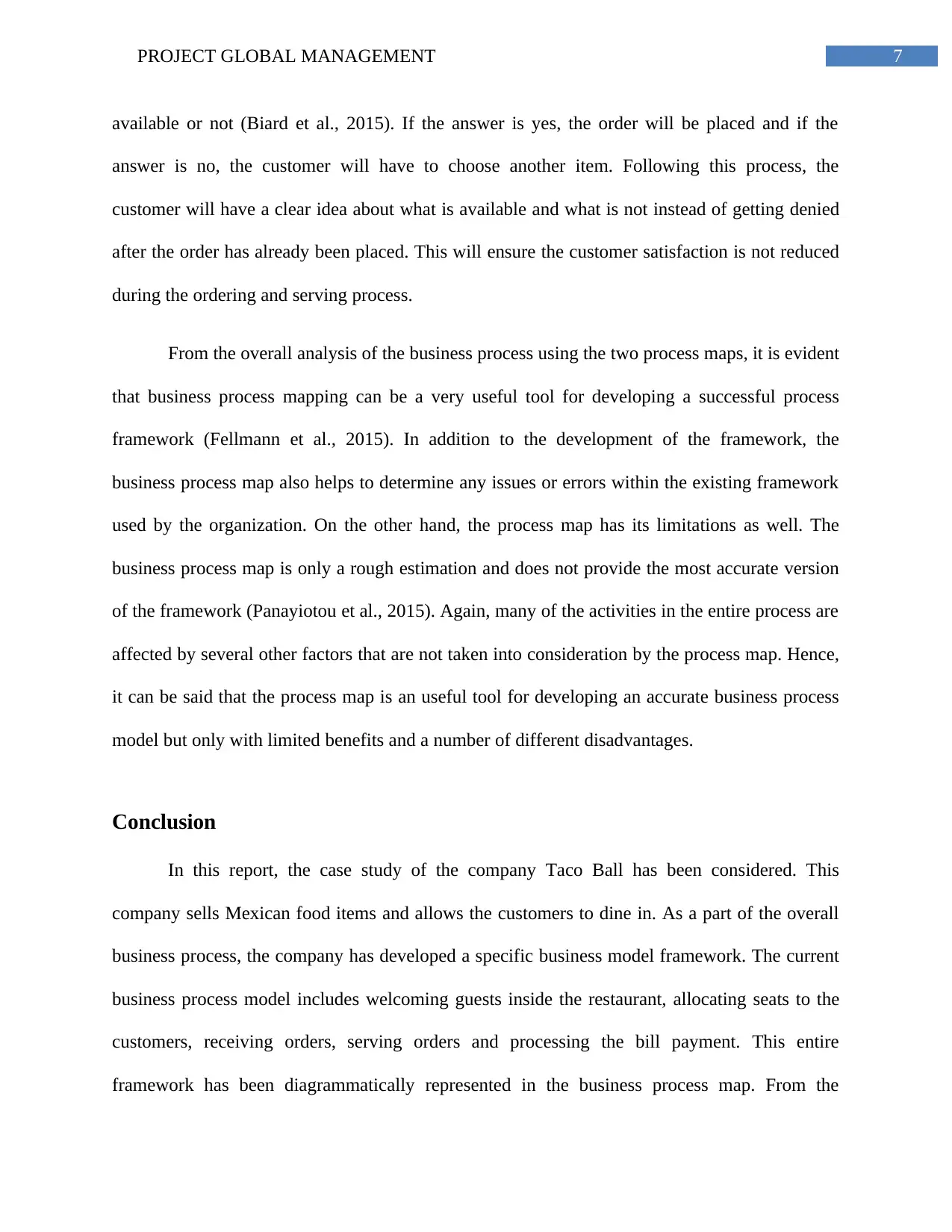
7PROJECT GLOBAL MANAGEMENT
available or not (Biard et al., 2015). If the answer is yes, the order will be placed and if the
answer is no, the customer will have to choose another item. Following this process, the
customer will have a clear idea about what is available and what is not instead of getting denied
after the order has already been placed. This will ensure the customer satisfaction is not reduced
during the ordering and serving process.
From the overall analysis of the business process using the two process maps, it is evident
that business process mapping can be a very useful tool for developing a successful process
framework (Fellmann et al., 2015). In addition to the development of the framework, the
business process map also helps to determine any issues or errors within the existing framework
used by the organization. On the other hand, the process map has its limitations as well. The
business process map is only a rough estimation and does not provide the most accurate version
of the framework (Panayiotou et al., 2015). Again, many of the activities in the entire process are
affected by several other factors that are not taken into consideration by the process map. Hence,
it can be said that the process map is an useful tool for developing an accurate business process
model but only with limited benefits and a number of different disadvantages.
Conclusion
In this report, the case study of the company Taco Ball has been considered. This
company sells Mexican food items and allows the customers to dine in. As a part of the overall
business process, the company has developed a specific business model framework. The current
business process model includes welcoming guests inside the restaurant, allocating seats to the
customers, receiving orders, serving orders and processing the bill payment. This entire
framework has been diagrammatically represented in the business process map. From the
available or not (Biard et al., 2015). If the answer is yes, the order will be placed and if the
answer is no, the customer will have to choose another item. Following this process, the
customer will have a clear idea about what is available and what is not instead of getting denied
after the order has already been placed. This will ensure the customer satisfaction is not reduced
during the ordering and serving process.
From the overall analysis of the business process using the two process maps, it is evident
that business process mapping can be a very useful tool for developing a successful process
framework (Fellmann et al., 2015). In addition to the development of the framework, the
business process map also helps to determine any issues or errors within the existing framework
used by the organization. On the other hand, the process map has its limitations as well. The
business process map is only a rough estimation and does not provide the most accurate version
of the framework (Panayiotou et al., 2015). Again, many of the activities in the entire process are
affected by several other factors that are not taken into consideration by the process map. Hence,
it can be said that the process map is an useful tool for developing an accurate business process
model but only with limited benefits and a number of different disadvantages.
Conclusion
In this report, the case study of the company Taco Ball has been considered. This
company sells Mexican food items and allows the customers to dine in. As a part of the overall
business process, the company has developed a specific business model framework. The current
business process model includes welcoming guests inside the restaurant, allocating seats to the
customers, receiving orders, serving orders and processing the bill payment. This entire
framework has been diagrammatically represented in the business process map. From the

8PROJECT GLOBAL MANAGEMENT
analysis of the representation developed in the map, it has been observed that some additional
decision making steps will further enhance the model. The decision making steps mainly have
two different outcomes based on whether the answer is yes or no. According to the new decision
making steps identified for the model, another recommended model has been developed in which
these two particular steps have been added within the existing sequence. From the study of the
business process using the two process maps, it is evident that business process mapping can be a
very useful tool for developing a successful process framework and hence, they have been
suitably used for developing the existing and proposed models of the chosen company.
analysis of the representation developed in the map, it has been observed that some additional
decision making steps will further enhance the model. The decision making steps mainly have
two different outcomes based on whether the answer is yes or no. According to the new decision
making steps identified for the model, another recommended model has been developed in which
these two particular steps have been added within the existing sequence. From the study of the
business process using the two process maps, it is evident that business process mapping can be a
very useful tool for developing a successful process framework and hence, they have been
suitably used for developing the existing and proposed models of the chosen company.
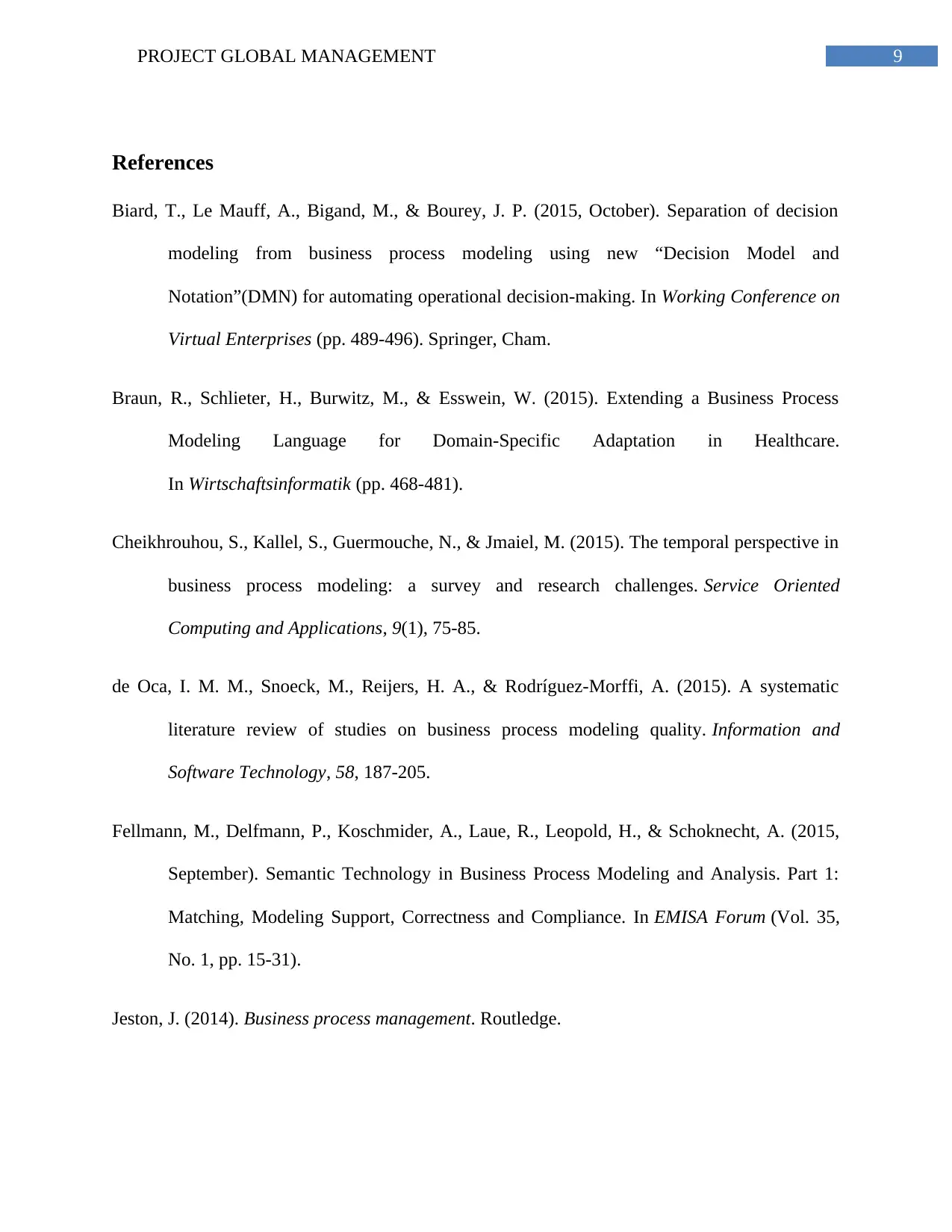
9PROJECT GLOBAL MANAGEMENT
References
Biard, T., Le Mauff, A., Bigand, M., & Bourey, J. P. (2015, October). Separation of decision
modeling from business process modeling using new “Decision Model and
Notation”(DMN) for automating operational decision-making. In Working Conference on
Virtual Enterprises (pp. 489-496). Springer, Cham.
Braun, R., Schlieter, H., Burwitz, M., & Esswein, W. (2015). Extending a Business Process
Modeling Language for Domain-Specific Adaptation in Healthcare.
In Wirtschaftsinformatik (pp. 468-481).
Cheikhrouhou, S., Kallel, S., Guermouche, N., & Jmaiel, M. (2015). The temporal perspective in
business process modeling: a survey and research challenges. Service Oriented
Computing and Applications, 9(1), 75-85.
de Oca, I. M. M., Snoeck, M., Reijers, H. A., & Rodríguez-Morffi, A. (2015). A systematic
literature review of studies on business process modeling quality. Information and
Software Technology, 58, 187-205.
Fellmann, M., Delfmann, P., Koschmider, A., Laue, R., Leopold, H., & Schoknecht, A. (2015,
September). Semantic Technology in Business Process Modeling and Analysis. Part 1:
Matching, Modeling Support, Correctness and Compliance. In EMISA Forum (Vol. 35,
No. 1, pp. 15-31).
Jeston, J. (2014). Business process management. Routledge.
References
Biard, T., Le Mauff, A., Bigand, M., & Bourey, J. P. (2015, October). Separation of decision
modeling from business process modeling using new “Decision Model and
Notation”(DMN) for automating operational decision-making. In Working Conference on
Virtual Enterprises (pp. 489-496). Springer, Cham.
Braun, R., Schlieter, H., Burwitz, M., & Esswein, W. (2015). Extending a Business Process
Modeling Language for Domain-Specific Adaptation in Healthcare.
In Wirtschaftsinformatik (pp. 468-481).
Cheikhrouhou, S., Kallel, S., Guermouche, N., & Jmaiel, M. (2015). The temporal perspective in
business process modeling: a survey and research challenges. Service Oriented
Computing and Applications, 9(1), 75-85.
de Oca, I. M. M., Snoeck, M., Reijers, H. A., & Rodríguez-Morffi, A. (2015). A systematic
literature review of studies on business process modeling quality. Information and
Software Technology, 58, 187-205.
Fellmann, M., Delfmann, P., Koschmider, A., Laue, R., Leopold, H., & Schoknecht, A. (2015,
September). Semantic Technology in Business Process Modeling and Analysis. Part 1:
Matching, Modeling Support, Correctness and Compliance. In EMISA Forum (Vol. 35,
No. 1, pp. 15-31).
Jeston, J. (2014). Business process management. Routledge.
Secure Best Marks with AI Grader
Need help grading? Try our AI Grader for instant feedback on your assignments.
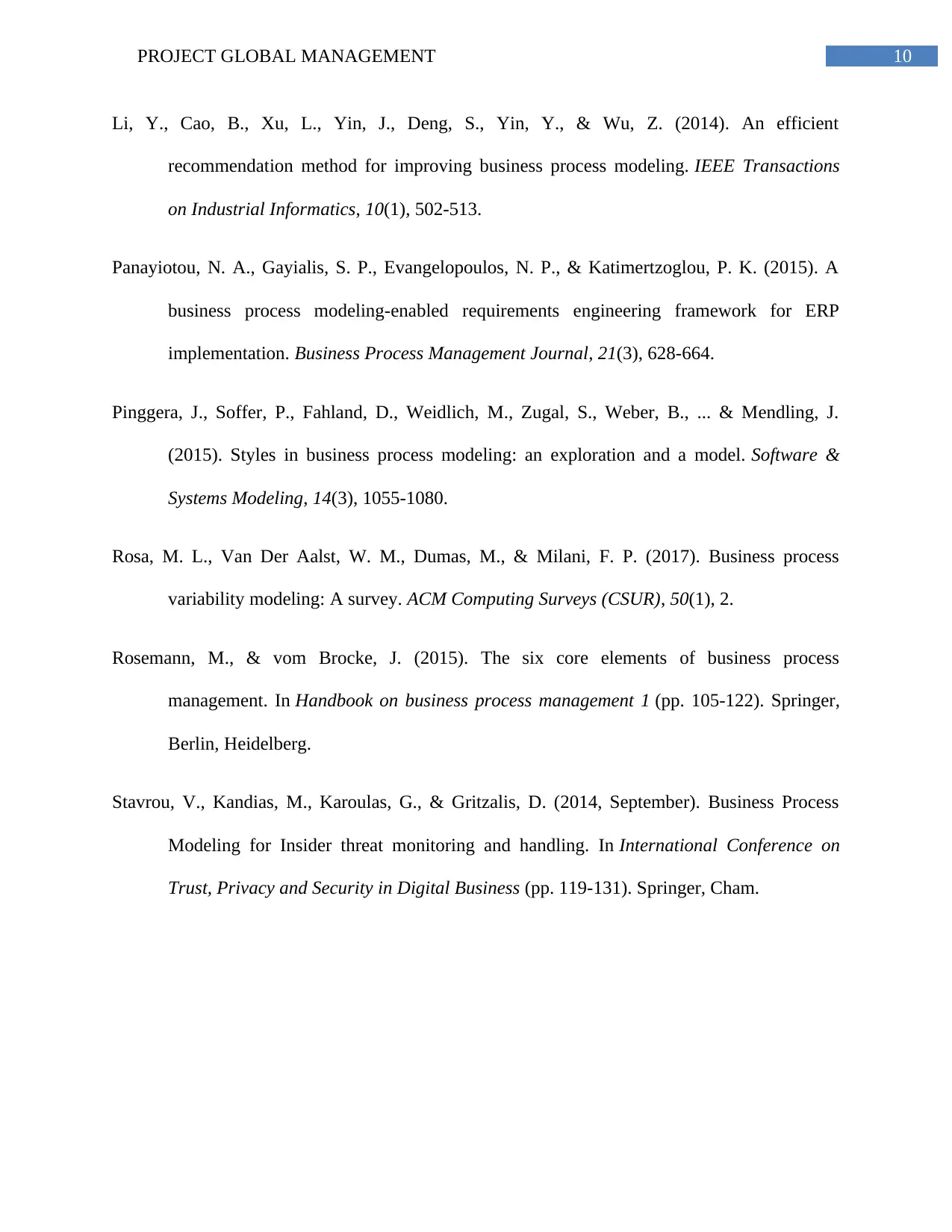
10PROJECT GLOBAL MANAGEMENT
Li, Y., Cao, B., Xu, L., Yin, J., Deng, S., Yin, Y., & Wu, Z. (2014). An efficient
recommendation method for improving business process modeling. IEEE Transactions
on Industrial Informatics, 10(1), 502-513.
Panayiotou, N. A., Gayialis, S. P., Evangelopoulos, N. P., & Katimertzoglou, P. K. (2015). A
business process modeling-enabled requirements engineering framework for ERP
implementation. Business Process Management Journal, 21(3), 628-664.
Pinggera, J., Soffer, P., Fahland, D., Weidlich, M., Zugal, S., Weber, B., ... & Mendling, J.
(2015). Styles in business process modeling: an exploration and a model. Software &
Systems Modeling, 14(3), 1055-1080.
Rosa, M. L., Van Der Aalst, W. M., Dumas, M., & Milani, F. P. (2017). Business process
variability modeling: A survey. ACM Computing Surveys (CSUR), 50(1), 2.
Rosemann, M., & vom Brocke, J. (2015). The six core elements of business process
management. In Handbook on business process management 1 (pp. 105-122). Springer,
Berlin, Heidelberg.
Stavrou, V., Kandias, M., Karoulas, G., & Gritzalis, D. (2014, September). Business Process
Modeling for Insider threat monitoring and handling. In International Conference on
Trust, Privacy and Security in Digital Business (pp. 119-131). Springer, Cham.
Li, Y., Cao, B., Xu, L., Yin, J., Deng, S., Yin, Y., & Wu, Z. (2014). An efficient
recommendation method for improving business process modeling. IEEE Transactions
on Industrial Informatics, 10(1), 502-513.
Panayiotou, N. A., Gayialis, S. P., Evangelopoulos, N. P., & Katimertzoglou, P. K. (2015). A
business process modeling-enabled requirements engineering framework for ERP
implementation. Business Process Management Journal, 21(3), 628-664.
Pinggera, J., Soffer, P., Fahland, D., Weidlich, M., Zugal, S., Weber, B., ... & Mendling, J.
(2015). Styles in business process modeling: an exploration and a model. Software &
Systems Modeling, 14(3), 1055-1080.
Rosa, M. L., Van Der Aalst, W. M., Dumas, M., & Milani, F. P. (2017). Business process
variability modeling: A survey. ACM Computing Surveys (CSUR), 50(1), 2.
Rosemann, M., & vom Brocke, J. (2015). The six core elements of business process
management. In Handbook on business process management 1 (pp. 105-122). Springer,
Berlin, Heidelberg.
Stavrou, V., Kandias, M., Karoulas, G., & Gritzalis, D. (2014, September). Business Process
Modeling for Insider threat monitoring and handling. In International Conference on
Trust, Privacy and Security in Digital Business (pp. 119-131). Springer, Cham.
1 out of 11
Related Documents
Your All-in-One AI-Powered Toolkit for Academic Success.
+13062052269
info@desklib.com
Available 24*7 on WhatsApp / Email
![[object Object]](/_next/static/media/star-bottom.7253800d.svg)
Unlock your academic potential
© 2024 | Zucol Services PVT LTD | All rights reserved.





